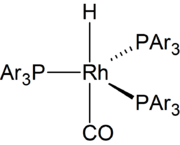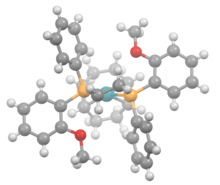Organorhodium chemistry
Organorhodium chemistry is the chemistry of organometallic compounds containing a rhodium-carbon chemical bond, and the study of rhodium and rhodium compounds as catalysts in organic reactions.[1]

Stable organorhodium compounds and transient organorhodium intermediates are used as catalyst such as in olefin hydroformylation, olefin hydrogenation, olefin isomerization and the Monsanto process[2]
Classification based on principal oxidation states
Organometallic rhodium compounds share many characteristics with those of iridium, but less so with cobalt. Rhodium can exist in oxidation states of -III to +V, but rhodium(I) and rhodium(III) are the more common. Rhodium(I) compounds (d8 configuration) usually occur with square planar or trigonal bipyramidal geometries, while rhodium (III) compounds (d6 configuration) typically have an octahedral geometry.[2]
Rhodium(0)
Rhodium(0) complexes are binary carbonyls, the principal examples being tetrarhodium dodecacarbonyl, Rh4(CO)10, and hexadecacarbonylhexarhodium, Rh6(CO)16. These compounds are obtained by reductive carbonylation of rhodium(III) salts or Rh2Cl2(CO)4. In contrast to the stability of the homologous Co2(CO)8, Rh2(CO)8 is very labile.
Rhodium(I)
Rhodium(I) complexes are important homogeneous catalysts. Common complexes include bis(triphenylphosphine)rhodium carbonyl chloride, chlorobis(ethylene)rhodium dimer, cyclooctadiene rhodium chloride dimer, chlorobis(cyclooctene)rhodium dimer, dicarbonyl(acetylacetonato)rhodium(I), and rhodium carbonyl chloride. Although not formally organometallic, Wilkinson's catalyst (RhCl(PPh3)3), is included in the list of important catalysts. The simple olefin complexes chlorobis(ethylene)rhodium dimer, chlorobis(cyclooctene)rhodium dimer, and cyclooctadiene rhodium chloride dimer are often used as sources of "RhCl", exploiting the lability of the alkene ligands or their susceptibility to removal by hydrogenation. (η5-Cp)RhL2 are derived from Rh2Cl2L4 (L = CO, C2H4).
Rhodium(II)
Unlike the prevalence of cobalt(II) complexes, compounds of rhodium(II) are rare. The sandwich compound rhodocene is one example, even it exists in equilibrium with a dimeric Rh(I) derivative. Although not organometallic, rhodium(II) acetate (Rh2(OAc)4) catalyzes cyclopropanations via organometallic intermediates. Rhodium(II) porphyrin complexes react with methane.[3]
Rhodium(III)
Rhodium is usually supplied commercially in the Rh(III) oxidation state, the main starting reagent being hydrated rhodium trichloride. The latter reacts with olefins and with CO to give organometallic complexes, often concomitant with reduction to Rh(I). Cyclopentadienyl complexes of rhodium include the half-sandwich compound pentamethylcyclopentadienyl rhodium dichloride dimer.
Rhodium(V)
Strong donor ligands - hydride, silyl, boryl - are required to stabilize Rh(V). This oxidation state is invoked in borylation reactions.

Major applications
Despite its high cost, rhodium is heavily relied on as a commercial catalyst.
Acetic acid and acetic anhydride syntheses
The Monsanto process is an industrial method for the manufacture of acetic acid by catalytic carbonylation of methanol,[4] although it has largely been supplanted by the iridium-based Cativa process.

The catalytically active species is the anion cis-[Rh(CO)2I2]−.[5] which undergoes oxidative addition with methyl iodide. The related Tennessee Eastman acetic anhydride process affords acetic anhydride by carbonylation of methyl acetate.[6]
- CH3CO2CH3 + CO → (CH3CO)2O
Hydroformylation

Hydroformylations often rely on rhodium-based catalysts. Water-soluble catalysts have also been developed. They facilitate the separation of the products from the catalyst.[7]
Hydrogenation
Wilkinson's catalyst is used as a homogeneous catalyst for the hydrogenation of olefins.[8] The mechanism of catalysis involves oxidative addition of H2, π-complexation of alkene, migratory insertion (intramolecular hydride transfer or olefin insertion), and reductive elimination.
Cationic organorhodium(I) catalysts are useful for asymmetric hydrogenations, which are applied to bioactive products such as pharmaceutical agents and agrochemicals.[9]
References
- Synthesis of Organometallic Compounds: A Practical Guide Sanshiro Komiya Ed. S. Komiya, M. Hurano 1997
- Crabtree, Robert H. (2005). The Organometallic Chemistry of the Transition Metals (4th ed.). USA: Wiley-Interscience. ISBN 0-471-66256-9.
- Bradford B. Wayland, Sujuan Ba, Alan E. Sherry (1991). "Activation of Methane and Toluene by Rhodium(II) Porphyrin Complexes". J. Am. Chem. Soc. 113: 5305–5311. doi:10.1021/ja00014a025.CS1 maint: uses authors parameter (link)
- Hosea Cheung, Robin S. Tanke, G. Paul Torrence "Acetic Acid" in Ullmann's Encyclopedia of Industrial Chemistry, 2002, Wiley-VCH, Weinheim. doi:10.1002/14356007.a01_045
- Hartwig, J. F. Organotransition Metal Chemistry, from Bonding to Catalysis; University Science Books: New York, 2010. ISBN 189138953X
- Zoeller, J. R.; Agreda, V. H.; Cook, S. L.; Lafferty, N. L.; Polichnowski, S. W.; Pond, D. M. (1992). "Eastman Chemical Company Acetic Anhydride Process". Catalysis Today. 13 (1): 73–91. doi:10.1016/0920-5861(92)80188-S.
- Cornils, B.; Herrmann, W. A. (eds.) “Aqueous-Phase Organometallic Catalysis” VCH, Weinheim: 1998
- Hartwig, John F. (2010). Organotransition metal chemistry- From bonding to Catalysis. University Science Books. ISBN 978-1-891389-53-5.
- Knowles, William S. (2002). "Asymmetric Hydrogenations (Nobel Lecture)". Angewandte Chemie International Edition. 41: 1998. doi:10.1002/1521-3773(20020617)41:12<1998::AID-ANIE1998>3.0.CO;2-8.
- H.-J.Drexler, Songlin Zhang, Ailing Sun, A. Spannenberg, A. Arrieta, A. Preetz, D. Heller. "Cationic Rh-bisphosphine-diolefin complexes as precatalysts for enantioselective catalysis––what information do single crystal structures contain regarding product chirality?". Tetrahedron: Asymmetry. 15: 2139–50. doi:10.1016/j.tetasy.2004.06.036.CS1 maint: uses authors parameter (link)
